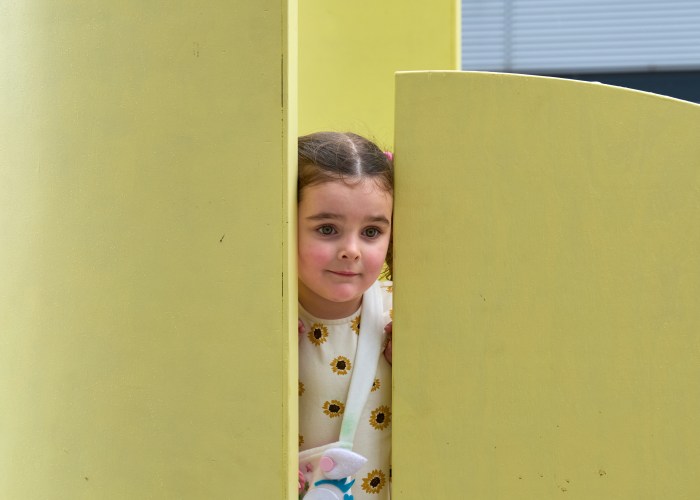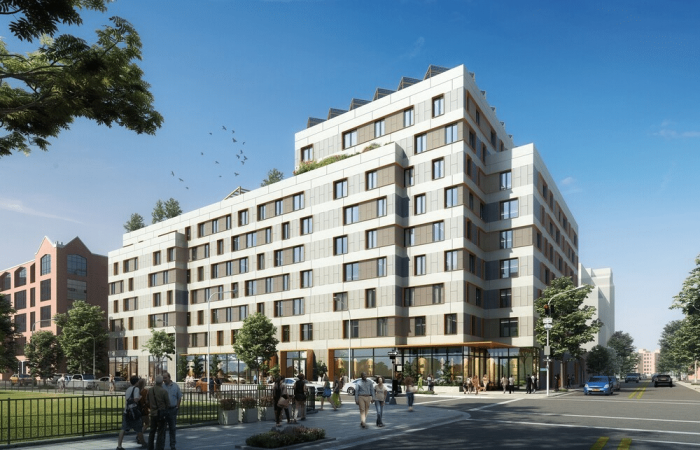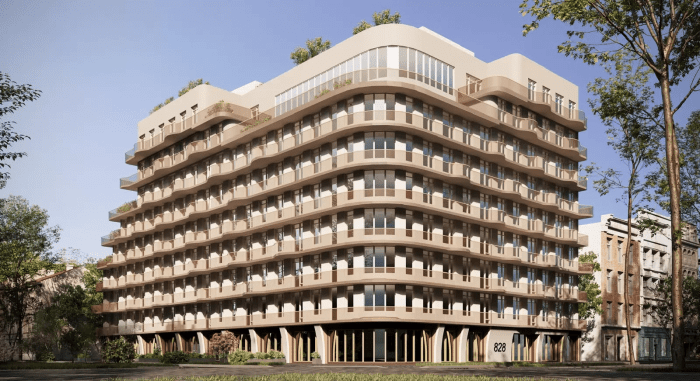“Kill the 12-story monster,” read a hand-painted sign sprouting up amid weeds and abandoned toys in a lot on Fourth Avenue and 12th Street.
“Monster” referred to a residential tower destined for another vacant lot across the street. It also advertised a June 13 meeting, which attracted 81 residents troubled about the pace of development.
The Park Slope South Community — an incipient group borne from the meeting — is manning the barricades in what has become Brooklyn’s latest divisive battle: one faction wants to develop a neighborhood, another unites to protect that neighborhood’s “character.”
Both sides can’t win, can they?
Tall buildings are rising on Fourth Avenue thanks to the 2003 rezoning of Park Slope, which protected low-rise residential streets from developers’ plans, while turning commercial thoroughfares, particularly Fourth Avenue between Union and 15th streets, into blank canvases for redevelopment.
The zoning regulations now allow developers to build as high as 120 feet and to extend those buildings 100 feet down side streets.
The more-permissive zoning has already spurred a flurry of development. Now Fourth Avenue — once a place to get your flat fixed — aspires to become a true part of gentrified Park Slope.
“Any piece of land that can be gotten there and developed is being bought up,” said Roslyn Huebener, a longtime real-estate broker in the neighborhood.
But with growth comes growing pains. And what is a boon for some — apartment buyers and the developers who court them — is a tragedy for others.
• • •
Lillian Striano lives within 100 feet of Fourth Avenue on 11th Street, a block of meticulously maintained rowhouses. A number of them date to the late 1800s and have been in the same family for generations.
While many of her neighbors have sold their houses to developers for astronomical profits, Striano is holding onto her home of 37 years.
Striano, 83, grew up around the corner. Her husband Sal, to whom she’s been married for 64 years, was born down the block.
“I thought our next stop would be Green-Wood Cemetery,” said Striano. “I never thought I’d be asked to move.”
But she was. Striano says she’s been repeatedly pressured by developer Bailing Yang to sell.
Yang has already snatched up the houses on either side of Striano and has bought properties around the corner on Fourth Avenue, including the Laundromat.
“I don’t care what you offer me,” said Striano. “I want my house.”
The offers are getting harder and harder to refuse.
The three-story house next door sold for $860,000 in April, and the two-story house on the other side supposedly sold for even more.
And that’s peanuts compared to the price tags on some nearby homes.
A three-story building at 488 Fourth Ave. that sold last October for $1.38 million is now selling for $2.1 million. Across the street, a four-story building is selling for $2.15 million. Tellingly, both are listed by Massey Knakal — the real-estate behemoth — as “development sites.”
A development site is “a place where you would build a new building,” said Massey Knakal agent Kenneth Freeman. “The Fourth Avenue market right now has tremendous upside. It’s not there yet, but I have every reason to believe it will be there.”
Freeman says that the condos being built up and down Fourth Avenue offer attractive amenities to the flood of people coursing into Brooklyn — the well-regarded PS 321, an easy commute to Manhattan, and relative proximity to Prospect Park.
He’s not alone.
“[Fourth Avenue] is a nice street,” said Yang. “It has an island in the middle, and it can have trees. It can become like Park Avenue of Manhattan.”
Neither Yang nor developer Isaac Katan wants to let the opportunity pass. Katan has 200 units under construction in towers at Fifth and Second streets — and in the next five months, he’ll start excavation on another 200.
In total, there are 12 new buildings rising between Union and 15th streets, according to Community Board 6 District Manager Craig Hammerman. Most notably, there are two Shaya Boymelgreen towers going up — one near the Old Stone House at Fourth Street and another nearby.
It’s not just the condo and coop market that’s booming.
Urban View Realty was showing two, two-bedroom rentals on Fourth Avenue for $2,000 a piece.
“These went in a week or two — so fast,” said Olivia Prudhomme, an agent. The neighborhood’s so hot that some apartments are rented the same day they are listed.
And with new residents, comes retail.
“[Now] you can charge up to $60 a foot on Fourth Avenue for retail,” marveled Katan. “Nobody was thinking or dreaming a few years ago to get even $30 a foot.”
Retailers on Seventh Avenue — a much more established and pedestrian-friendly commercial sector — pay upwards of $75 per square foot.
“Fourth Avenue would appear to be coming of age,” said Ken Adams, president of the Brooklyn Chamber of Commerce. “It’s certainly not a retail backwater anymore.”
• • •
Development in Park Slope has been proceeding in fits and starts for years.
In the early 1990s, Park Slope north of Union Street was rezoned to protect the character of the neighborhood. The success of that rezoning led its 2003 extension south to 15th Street.
Fourth Avenue — a wide street well-served by public transportation — was reconceived as the “Park Avenue of Brooklyn.”
“Fourth Avenue [is seen] as a safety valve,” said Hammerman. “Some of the market pressures on the rest of neighborhood can be released onto a wide street that could better support housing density.
“At the time, one would have been hard-pressed to find any opponents to the plan,” he added.
• • •
Development — and overdevelopment — have become the issue of the day in Brooklyn, and given the statistics, it’s no surprise.
Forty-two percent of New Yorkers earn less than $32,000 a year. In 2002, they had access to 1.2 million rental units. By 2005, the number was down to 985,000 units, according to an NYU study, which also concluded that rents have increased 8 percent citywide in just three years.
Further exacerbating the housing crunch on Fourth Avenue is the fact that affordable housing provisions were not included in the 2003 rezoning.
• • •
Development along Fourth Avenue may be unavoidable, but residents are taking a stand.
Striano and another neighbor’s refusal to sell their houses makes it impossible for Yang to carry out her plan on Fourth Avenue.
“For a while I was quite positive I was doing something,” said Yang. “But there have been some changes of plans.”
Striano has held off the developers, for now.























